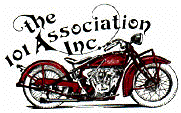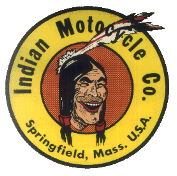Easiest question first.
- What is the standard length, center to center, of the connecting rods ?
Indian 45ci = 188,1mm/7.406" (my rods. Other lists 188,01mm/7.402")
Indian 37ci = 181,7mm/7.156"
Indian 74ci = 206,375mm/8.125"
Indian 741 = 183,8mm/7.238"
Indian 30.50 = 183,8mm/7.238"
HD 45ci = 188,91mm/7.4375"
------------------
- How much clearance should the valve guides have ?
A snippet from Jim Moshers site:
http://www.performanceindian.com/Valves%20&%20Springs.html
Indian valve guides
Indian always used very hard iron valve guides. Unfortunately, it's hard to find new guides that are as hard. Gary Stark of Starklite Cycle is selling the best guides that I have found. They are very hard, and last a long time. There is no "second best". He is now making a good Scout valve guide, but it's not uncommon to see valve guide holes that are worn large, where even his .002" oversize guides will be too loose. So, then, I make my own guides. I found a very tough iron that can be bought in short blanks,with a precise inner hole, and I finish them on my lathe. You can use either iron, or bronze for intake guides, but I have had troubles using bronze for exhausts. I use "G2 Ductile Iron" for my exhaust guides. It is a super hard iron, and once I hone them, they last under the severe use of my Twin-Scout on Nitrous at Bonneville.
I don't like reaming guides as much as I like honing them. With honing, you get a very straight, and round hole. I use "Pin Gauges" in various sizes to test the hole size to get the right stem to guide clearance. I have found that Chief's like .004" for intakes, and .0045"-.005" for exhausts. For Scouts, I like .0035" for intakes, and .004"-.0045" for exhausts. If they are too tight, they will gaul, and stick, or wear alot. If they are too loose, you will get a bad pattern of wear at the valve seats, plus alot of oil consumption.
------------------------
- how much is the normal compression height of the pistons on our 45ci engines ?
It depends. On alot.
Engine use version, piston material, piston manufacturer, year of manufacture.
Comp height can vary from low compression engines with 34mm, to high comp. up and above 42mm in 45ci engines. Taller pistons from about 41 to above 45mm is found in 37ci engines.
-------------------
- Do the top of the pistons have to come up equally with the top of the cylinders at TDC ?
I got here in Indian boxes, a pair of New old stock 0,005"OD Lynite No.86517, with chamfered tops. Manuf. year unknown but a guess is 1936 SS. They are T-slotted and has 4 rings, 3 comp rings width 1,5mm, 1 oil ring width 3,8mm. The top chamfer is cut 30 deg. from skirt wall, and 2mm deep. Total height 72,5mm. Weight 256/258 gr. without rings and pin. They have a compression height of 38,1mm.
Deck height of the crankcase is 124mm and the 45ci cylinder height is 152,4mm and with a rod of 188,1mm leaves 39,45mm plus base gasket thickness for piston comp.height up to the cylinder deck, if my calculations are right.


